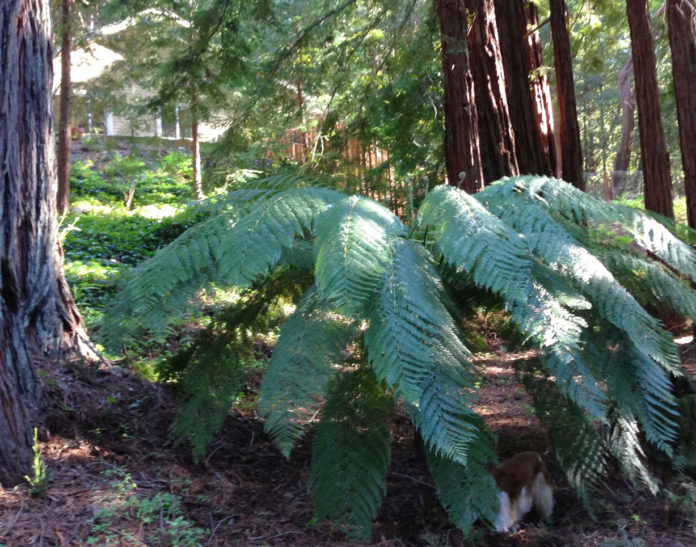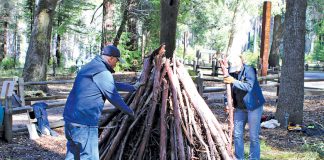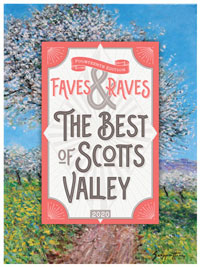I was talking to someone recently who said she lived in Bonny Doon. When I told her I used to live on Robles Drive but lost the house in the CZU fire, she asked, “Did you live in the house with that huge Tasmanian tree fern?” I told her yes and added that it was 50 years old at the time of the fire, having been planted by the original builder of the house. I guess it qualified as a heritage plant. There is so much horticultural history in our area. I’m fascinated by it all.
This area is rich in history. I love to look at old photos and try to identify what the early settlers planted around their homes in the Santa Cruz Mountains.
I’ve spent hours reading through the history of the Alba Schoolhouse online. Besides the history of the actual schoolhouse, which dates back to 1895, there are many first person accounts of who grew what crops and how the land along Alba Road was used and is part of our local horticultural history.
Did you know that vineyards stretched along the west side of Empire Grade opposite the eventual route of Alba Road? In 1884, as many as 2,000 gallons of wine was produced? The Burns family also had cattle on their ranch. A 1915 photo of their house shows palms and hollyhocks, too. Ben Lomond became known for fruit other than grapes. Orchards of prize-winning apples, peaches and plums were planted as well as strawberry plants. These crops thrived in the sunshine created by the clear cutting of timber.
Out on Bear Creek Road, the Ercoli villa featured yucca, which I saw in many early photographs. Most likely they originated from the deserts in southern California and Mexico and were brought north by the missionaries.
California fan palms and canna lilies appear in many early landscapes. The Middleton house in Boulder Creek was heavily planted with native western sword ferns. Black locust trees were planted for their fragrance and flowers and are still seen here today where they have naturalized. Originally planted for erosion control, particularly on strip mined areas, their durable timber was used for homes.
Many settlers arrived from the East Coast, the midwest and Europe and brought with them seeds and starts of plants. As early as 1871, nurseries in San Francisco were importing plants, such as pittosporum tenuifolium, and the 1915 Panama Pacific Exposition in San Francisco allowed many more plants to become available to homeowners. Hebe from New Zealand was all the rage. The brochure for this World Fair describes a Palace of Horticulture and Tower of Jewels as “… a great garden, itself, a marvel of landscape engineering skill… one side of a magic carpet on which these beautiful palaces are set with its floricultural splendors for a wondrous beauty, has never been equaled.”
The 1915 Panama Pacific Expo introduced more than plants to the public. In 1916, construction of a home in Brookdale featured timber, flooring and doors shipped from the Expo to this area by Southern Pacific railroad. When the house was finished in 1926, photographs show a beautiful home surrounded by hollyhocks, roses and wisteria.
My interest in early local horticulture started after looking at a friend’s family photographs from the early 1900s. His family had a resort with a natural spring and rock-lined forest paths close to Highway 9 in South Felton. This was very near the Big Tree Grove resort (now Toll House) that opened in 1867. I remember looking at the photos and marveling at all the flowers surrounding the dwelling. The redwood trees have now grown back but at that time there was lots of sunshine, a by-product of clear cutting. I could see roses, lilacs and Shasta daisies in the photo surrounding a wrap around porch.
Beginning in the 1930s, peat moss was removed from Scotts Valley and taken to San Francisco to supply soil and fertilizer for difficult indoor plants such as gardenias. The land from Burger King on Scotts Valley Drive over to Safeway on Mt Hermon Road was a peat bog. When the peat ran out, sand and gravel were quarried and sold. There were apple and cherry orchards at the north end of town and vineyards on both sides of Highway 17. The subdivision, The Vineyard, was named to memorialize the past land use.
I’d love to hear from those whose families lived in our valleys in the early 1900s and what they know about the plants and crops that were grown back then. You can tell a lot about landscape plants from old photographs. It’s a fun trip down memory lane and part of our horticultural heritage. You might even plant a historical garden for the fun of it.
Jan Nelson, a landscape designer and California-certified nursery professional, will answer questions about gardening in the Santa Cruz Mountains. Email her at ja******@*ol.com, or visit jannelsonlandscapedesign.com.











